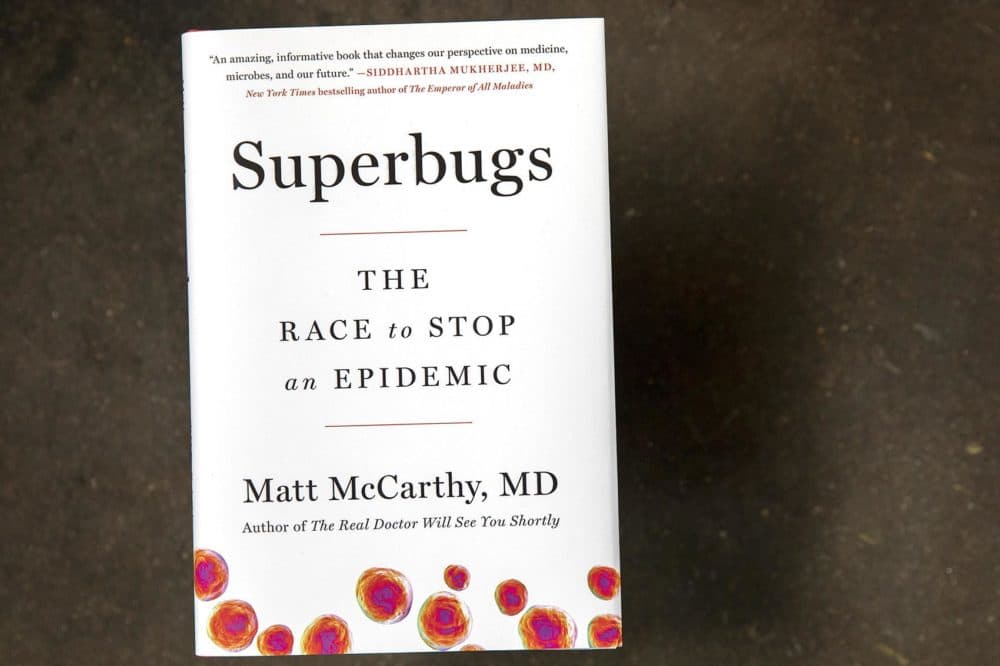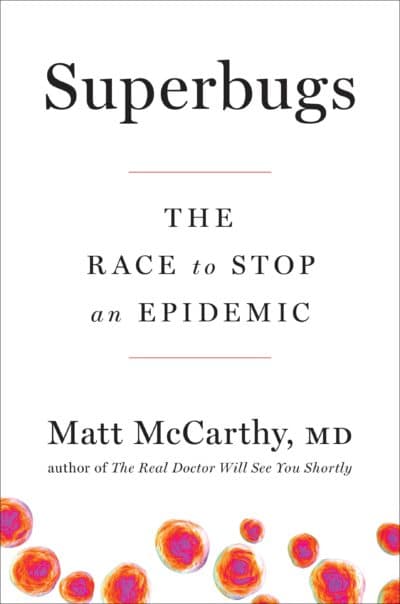Advertisement
What One Doctor Is Doing To Fight Antibiotic-Resistant 'Superbugs'

With Meghna Chakrabarti
A doctor’s story of what it takes to save patients from increasingly deadly pathogens. As drug-resistant bacteria spread, can new genomic science battle back the superbugs?
Guest
Matt McCarthy, staff physician at New York Presbyterian Hospital. Assistant professor of medicine at Weill Cornell Medical College. Author of "Superbugs: The Race to Stop an Epidemic." (@DrMattMcCarthy)
From The Reading List
Excerpt from "Superbugs" by Matt McCarthy
Fleming’s chance discovery of the first antibiotic is enough to spark the imagination of any child with a budding interest in science, but the discovery of the first antifungal drug is equally compelling. It’s a story about two brilliant women that has been omitted from most science books, and it’s unknown to most of today’s young physicians.
Elizabeth Hazen was orphaned when she was just three. She spent the majority of her childhood bouncing around rural Mississippi at the turn of the twentieth century, living first with her grandmother and then with her uncle. After high school, she attended what is now known as the Mississippi University for Women and then moved to New York to study bacteriology at Columbia University. Her studies were interrupted by World War I, during which she served in the army, but she eventually obtained a doctorate before moving to New York City’s Division of Laboratories and Research in 1931.
Advertisement

A dozen years later, during World War II, physicians noticed that penicillin was protecting soldiers from bacterial infections, but many were contracting fungal diseases. There was no cure, and some suspected that Fleming’s discovery was actually predisposing the men to the fatal infections. Elizabeth Hazen was tasked with finding a way to treat them. In her laboratory, she went about the painstaking project of isolating organisms found in soil samples and testing them against two fungi that were known to infect humans, Candida albicans and Cryptococcus neoformans. When Hazen had a potential hit, she mailed her samples in a mason jar to a chemist in Albany, New York, named Rachel Brown.
Upstate, Dr. Brown would purify the samples and send the drugs back to Hazen for testing in animals. Their work progressed at a blistering pace, and was made possible by the remarkable efficiency of the U.S. Postal Service. In just a few years, they reviewed thousands of molecules, but almost all the drugs that killed fungi in test tubes turned out to be highly toxic in animals. Finally, after years of searching, one worked. The compound destroyed fungi without harming animals or humans, and, of all places, it had been found in the garden of Hazen’s friend, Jessie Nourse. A bacterium in the soil was producing the antifungal drug; Hazen named it after her friend, Streptomyces noursei.
The two researchers announced their results at the New York meeting of the National Academy of Sciences in 1950 and immediately attracted interest from Big Pharma, which was entering its golden age. Hazen and Brown were suddenly rich and, briefly, famous. They invested their millions in a nonprofit that funded more research. They named their fungal drug nystatin, after the New York State Department of Health, and continued to collaborate throughout their lives, discovering two more antibiotics together.
Nystatin has saved countless lives—I prescribe it all the time—and it’s even used occasionally to restore damaged artwork. (After a flood in Florence, Italy, curators at Boboli Gardens sprayed nystatin on more than two hundred paintings to protect them from mold.) Its effect has been staggering: it is on the World Health Organization’s list of essential medicines and is one of the cheapest and most effective products on the market today. But the nystatin story isn’t taught to fledgling scientists, medical students, or residents. Forgetting this piece of history speaks to our failure as educators. Everyone knows about Alexander Fleming, but no one knows about Elizabeth Hazen and Rachel Brown.
Reprinted from SUPERBUGS: The Race to Stop an Epidemic by arrangement with Avery, a member of Penguin Group (USA) LLC, A Penguin Random House Company. Copyright © 2019, Matt McCarthy, MD.
New York Times: "Opinion: What Superbug Hunters Know That We Don’t" — "Antibiotic-resistant superbugs are everywhere. If your hospital claims it doesn’t have them, it isn’t looking hard enough.
"Hospitals are losing an important public relations battle over the expanding threat of superbugs, including the deadly fungus Candida auris. Though states are tasked with conducting outbreak investigations, they aren't required to disclose their findings to the Centers for Disease Control and Prevention (and in many cases they haven’t). Grieving families are pushing for more transparency, while patient advocates smell a cover-up, likening the scenario to a restaurant failing to report an outbreak of food poisoning. In the midst of all this mistrust, hospital spokesmen are declining to comment. This is a mistake.
"I hate to be the bearer of bad news, but these microbes are in our homes, cars and grocery stores. One study found that even after the use of disinfectant, more than half of hospital rooms still contain a superbug. Nurses and doctors carry these things around, too. Roughly 5 percent of health care workers are colonized with MRSA, a bacterium that kills thousands of people in the United States every year, and another study found that 10 percent of patients entering a hospital had a multidrug-resistant species on their hands. You don’t want to know what’s hiding on a handkerchief.
"Here’s the thing: You almost certainly don’t need to worry about any of this. Potentially deadly bacteria and fungi live harmlessly on our hands, feet, and faces, and may never cause a problem. There are trillions of bacteria living inside all of us. Why are we pretending they aren’t on our gurneys, blood pressure cuffs and X-ray machines?"
New York Times: "Opinion: The Scary Shortage of Infectious-Disease Doctors" — "Many have heard of the rise of drug-resistant infections. But few know about an issue that’s making this threat even scarier in the United States: the shortage of specialists capable of diagnosing and treating those infections. Infectious diseases is one of just two medicine subspecialties that routinely do not fill all of their training spots every year in the National Resident Matching Program (the other is nephrology). Between 2009 and 2017, the number of programs filling all of their adult-infectious-disease training positions dropped by more than 40 percent.
"This could not be happening at a worse time. Antibiotic-resistant microbes, known as superbugs, are pinballing around the world, killing hundreds of thousands of people every year. The Times recently reported on Candida auris, a deadly new fungus that has infected hospital patients in Illinois, New Jersey and New York.
"Everyone who works in health care agrees that we need more infectious-disease doctors, yet very few actually want the job. What’s going on?"
Hilary McQuilkin produced this hour for broadcast.
This program aired on May 23, 2019.